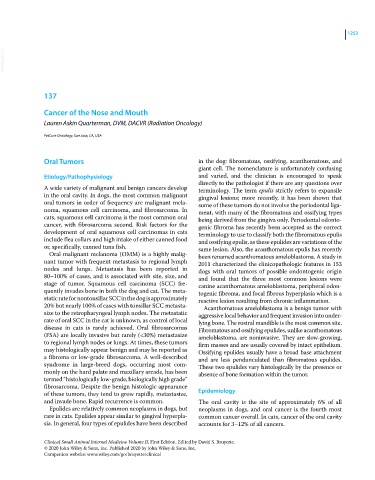Page 1315 - Clinical Small Animal Internal Medicine
P. 1315
1253
VetBooks.ir
137
Cancer of the Nose and Mouth
Lauren Askin Quarterman, DVM, DACVR (Radiation Oncology)
PetCure Oncology, San Jose, CA, USA
Oral Tumors in the dog: fibromatous, ossifying, acanthomatous, and
giant cell. The nomenclature is unfortunately confusing
Etiology/Pathophysiology and varied, and the clinician is encouraged to speak
directly to the pathologist if there are any questions over
A wide variety of malignant and benign cancers develop terminology. The term epulis strictly refers to expansile
in the oral cavity. In dogs, the most common malignant gingival lesions; more recently, it has been shown that
oral tumors in order of frequency are malignant mela- some of these tumors do not involve the periodontal liga-
noma, squamous cell carcinoma, and fibrosarcoma. In ment, with many of the fibromatous and ossifying types
cats, squamous cell carcinoma is the most common oral being derived from the gingiva only. Periodontal odonto-
cancer, with fibrosarcoma second. Risk factors for the genic fibroma has recently been accepted as the correct
development of oral squamous cell carcinomas in cats terminology to use to classify both the fibromatous epulis
include flea collars and high intake of either canned food and ossifying epulis, as these epulides are variations of the
or, specifically, canned tuna fish. same lesion. Also, the acanthomatous epulis has recently
Oral malignant melanoma (OMM) is a highly malig- been renamed acanthomatous ameloblastoma. A study in
nant tumor with frequent metastasis to regional lymph 2011 characterized the clinicopathologic features in 153
nodes and lungs. Metastasis has been reported in dogs with oral tumors of possible ondontogenic origin
80–100% of cases, and is associated with site, size, and and found that the three most common lesions were
stage of tumor. Squamous cell carcinoma (SCC) fre- canine acanthomatous ameloblastoma, peripheral odon-
quently invades bone in both the dog and cat. The meta- togenic fibroma, and focal fibrous hyperplasia which is a
static rate for nontonsillar SCC in the dog is approximately reactive lesion resulting from chronic inflammation.
20% but nearly 100% of cases with tonsillar SCC metasta- Acanthomatous ameloblastoma is a benign tumor with
size to the retropharyngeal lymph nodes. The metastatic aggressive local behavior and frequent invasion into under-
rate of oral SCC in the cat is unknown, as control of local lying bone. The rostral mandible is the most common site.
disease in cats is rarely achieved. Oral fibrosarcomas Fibromatous and ossifying epulides, unlike acanthomatous
(FSA) are locally invasive but rarely (<30%) metastasize ameloblastoma, are noninvasive. They are slow‐growing,
to regional lymph nodes or lungs. At times, these tumors firm masses and are usually covered by intact epithelium.
may histologically appear benign and may be reported as Ossifying epulides usually have a broad base attachment
a fibroma or low‐grade fibrosarcoma. A well‐described and are less pendunculated than fibromatous epulides.
syndrome in large‐breed dogs, occurring most com- These two epulides vary histologically by the presence or
monly on the hard palate and maxillary arcade, has been absence of bone formation within the tumor.
termed “histologically low‐grade, biologically high grade”
fibrosarcoma. Despite the benign histologic appearance
of these tumors, they tend to grow rapidly, metastasize, Epidemiology
and invade bone. Rapid recurrence is common. The oral cavity is the site of approximately 6% of all
Epulides are relatively common neoplasms in dogs, but neoplasms in dogs, and oral cancer is the fourth most
rare in cats. Epulides appear similar to gingival hyperpla- common cancer overall. In cats, cancer of the oral cavity
sia. In general, four types of epulides have been described accounts for 3–12% of all cancers.
Clinical Small Animal Internal Medicine Volume II, First Edition. Edited by David S. Bruyette.
© 2020 John Wiley & Sons, Inc. Published 2020 by John Wiley & Sons, Inc.
Companion website: www.wiley.com/go/bruyette/clinical

